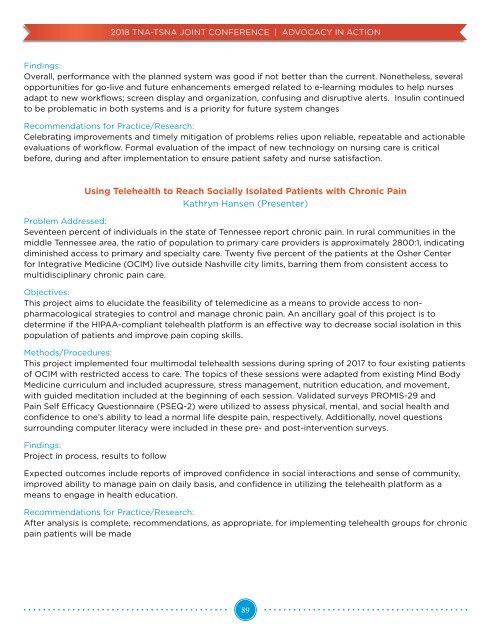2018 TNA and TSNA Joint Annual Conference
Create successful ePaper yourself
Turn your PDF publications into a flip-book with our unique Google optimized e-Paper software.
<strong>2018</strong> <strong>TNA</strong>-<strong>TSNA</strong> JOINT CONFERENCE | ADVOCACY IN ACTION<br />
Findings:<br />
Overall, performance with the planned system was good if not better than the current. Nonetheless, several<br />
opportunities for go-live <strong>and</strong> future enhancements emerged related to e-learning modules to help nurses<br />
adapt to new workflows; screen display <strong>and</strong> organization, confusing <strong>and</strong> disruptive alerts. Insulin continued<br />
to be problematic in both systems <strong>and</strong> is a priority for future system changes<br />
Recommendations for Practice/Research:<br />
Celebrating improvements <strong>and</strong> timely mitigation of problems relies upon reliable, repeatable <strong>and</strong> actionable<br />
evaluations of workflow. Formal evaluation of the impact of new technology on nursing care is critical<br />
before, during <strong>and</strong> after implementation to ensure patient safety <strong>and</strong> nurse satisfaction.<br />
Using Telehealth to Reach Socially Isolated Patients with Chronic Pain<br />
Kathryn Hansen (Presenter)<br />
Problem Addressed:<br />
Seventeen percent of individuals in the state of Tennessee report chronic pain. In rural communities in the<br />
middle Tennessee area, the ratio of population to primary care providers is approximately 2800:1, indicating<br />
diminished access to primary <strong>and</strong> specialty care. Twenty five percent of the patients at the Osher Center<br />
for Integrative Medicine (OCIM) live outside Nashville city limits, barring them from consistent access to<br />
multidisciplinary chronic pain care.<br />
Objectives:<br />
This project aims to elucidate the feasibility of telemedicine as a means to provide access to nonpharmacological<br />
strategies to control <strong>and</strong> manage chronic pain. An ancillary goal of this project is to<br />
determine if the HIPAA-compliant telehealth platform is an effective way to decrease social isolation in this<br />
population of patients <strong>and</strong> improve pain coping skills.<br />
Methods/Procedures:<br />
This project implemented four multimodal telehealth sessions during spring of 2017 to four existing patients<br />
of OCIM with restricted access to care. The topics of these sessions were adapted from existing Mind Body<br />
Medicine curriculum <strong>and</strong> included acupressure, stress management, nutrition education, <strong>and</strong> movement,<br />
with guided meditation included at the beginning of each session. Validated surveys PROMIS-29 <strong>and</strong><br />
Pain Self Efficacy Questionnaire (PSEQ-2) were utilized to assess physical, mental, <strong>and</strong> social health <strong>and</strong><br />
confidence to one’s ability to lead a normal life despite pain, respectively. Additionally, novel questions<br />
surrounding computer literacy were included in these pre- <strong>and</strong> post-intervention surveys.<br />
Findings:<br />
Project in process, results to follow<br />
Expected outcomes include reports of improved confidence in social interactions <strong>and</strong> sense of community,<br />
improved ability to manage pain on daily basis, <strong>and</strong> confidence in utilizing the telehealth platform as a<br />
means to engage in health education.<br />
Recommendations for Practice/Research:<br />
After analysis is complete, recommendations, as appropriate, for implementing telehealth groups for chronic<br />
pain patients will be made<br />
89

















